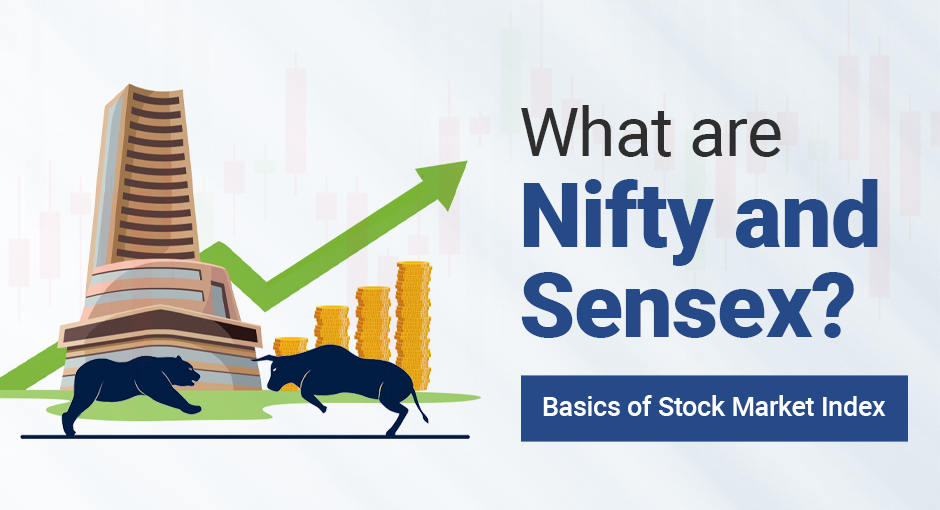
What are Nifty and Sensex? Basics of Stock Market Index
What are Nifty and Sensex? Basics of Stock Market Index
Nifty and Sensex are two of the most popular indices in India. Both indices cover the stock market activity in India. While Nifty is the main benchmark index for 50 top companies stocks listed on NSE, Sensex is used to track 30 top companies listed on BSE. However, there are some differences between these two indices which we will explore later in this blog.
Thank you for reading this post, don't forget to subscribe!What is the Stock Market Index?
The Stock Market Index is a way to measure how well any stock market is performing. It is a list of companies that have been selected to represent the entire stock market. These companies will typically be from different sectors and industries, so they can give investors an idea of how their investments are performing in relation to other investments in the same sector or industry.
Stock indices help investors understand which companies in their portfolio are doing well or poorly compared with other ones within the same industry and sector. This helps them decide when it’s time for them to sell some of those stocks that aren’t performing as well as expected, so they can reinvest in new ones without worrying about losing too much money on early sale fees (or “shorting” fees).
How Stock Market Index is calculated?
The index is calculated on a base of 100 points, which is set to be the value at which the total market capitalization of all stocks listed in the BSE was valued. This ensures that even if there is a huge fluctuation in company stock prices, the Sensex and Nifty remain constant indexes.
The Sensex and Nifty are also weighted averages. This means that they take into account how much each stock contributes to their respective indices as compared to others to arrive at an average number for both indices.
What is Nifty Index?
Nifty is an Indian stock market index. It is the benchmark index for the Indian equity market. Nifty is a free-float market capitalization-weighted index, which means that it takes into account only those companies that are available in public markets and whose stock can be traded freely by investors. The base value of Nifty was 100 points on December 31, 1986, when it first started tracking stocks listed on the National Stock Exchange (NSE).
What is Sensex Index?
The Sensex is an index of 30 large companies listed on the Bombay Stock Exchange (BSE). It is a price index, which means it tracks the prices of stocks rather than their market capitalization or value. The Sensex is calculated by taking the sum of the stock prices of all companies in the index and dividing it by a divisor. This results in an integer number, which represents how much a given share costs compared to what it did one year ago.
What is the difference between Sensex and Nifty?
Sensex is a price-weighted index, whereas Nifty is a market capitalization weighted.
Nifty includes 50 stocks and Sensex includes 30 stocks. It’s more diversified than Sensex due to this difference in the number of stocks included in each index.
The market cap of the companies that are part of Nifty is higher than those which are part of Sensex since there are more companies included in it (50).
When were the Sensex and Nifty launched?
The Nifty is a stock index of 50 blue chip companies in India. The Sensex, on the other hand, is an index of 30 large-cap publicly traded companies based in India that are listed on the Bombay Stock Exchange (BSE). Both were launched in their present form in 1996. Their predecessors were the BSE 100 and the BSE 200 indices respectively.
How did the stock market index change over time?
The highest stock market index for Nifty was recorded in October 2007, while the lowest index was recorded in February 2004. Between these two extremes is a wide range of fluctuation: from as low as 3200 to as high as 9100!
A popular way to measure market performance is called the “Relative Strength Index” (RSI). For example, if you want to know if your favourite stock price is rising or falling relative to other stocks, then an RSI reading will help you do so. Similarly, an RSI reading can tell us whether the overall market has been trending up or down over time by calculating how much each company’s share price has moved relative to its average share price over time (i.e., its historical average).
Relationship between Nifty and Sensex
Nifty is a subset of Sensex. That is, if you own an index fund that tracks the Nifty, your investment will also be exposed to the whole of the Indian stock market. However, it’s important to note that just because Nifty is a subset of Sensex doesn’t mean that all stocks in Nifty are also in Sensex. This can get confusing so let’s say it again:
If you own an index fund that tracks the Nifty—and only this one fund—you will be investing not only in all stocks listed on BSE/NSE but also in any other securities held by other financial institutions (banks, insurance companies, etc) or held as collateral for loans given out by them (securitization).
What are the companies part of Nifty and Sensex?
While the two indices measure the performance of 50 large-cap companies, they differ in their composition. Nifty is a 30-stock index that includes some of India’s most recognizable companies such as HDFC Bank and Tata Motors.
Sensex, on the other hand, is a broader index that includes 500 companies from all over India. While both indices have their place in Indian stock trading, Nifty is by far the most popular measure for tracking daily movements in stocks because it’s simpler to understand and easier to calculate than Sensex.
How to invest in Nifty and Sensex?
Nifty and Sensex are two of the most popular indices of India’s stock market. They help investors gauge how well the broader market is doing, both in terms of growth and stability. In other words, they provide a snapshot of how Indian stocks are performing at any given time.
Investing in these indexes is an easy way for people who don’t have enough time or knowledge to invest directly in individual stocks. Instead of trying to learn everything about every company you might want to invest in, all you need to do is buy shares that represent each index as a whole (or just one share).
How to track Nifty and Sensex?
The Nifty and Sensex are tracked on the BSE website. You can follow Nifty and Sensex on the Goodwill website. You can also get in touch with Goodwill Wealth Management and get free training on the stock market.
Conclusion
In this blog, we have given you a brief introduction to Nifty and Sensex. We hope that after reading this, you will be able to understand what these indices are, when they were launched and how they work. Moreover, we have also touched upon their relationship with each other so that you know how one affects the other and vice versa.
If you are interested in investing in Nifty and Sensex, then you go through Goodwill Wealth Management. They are the best equity broker in India, you will get to enjoy the lowest brokerage charges along with additional benefits. Additional benefits include free training for customers and GIGA the mobile trading app. So, register today and start trading the same day with India’s best equity broker.

